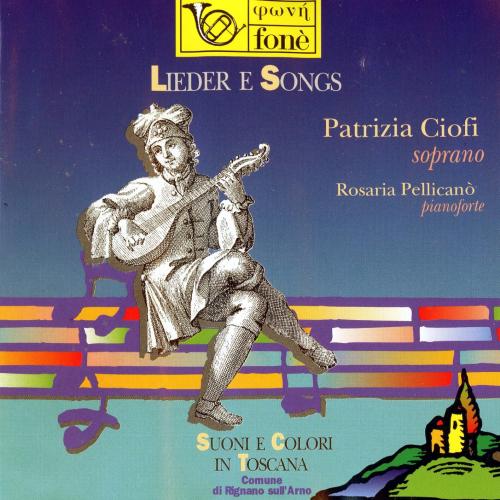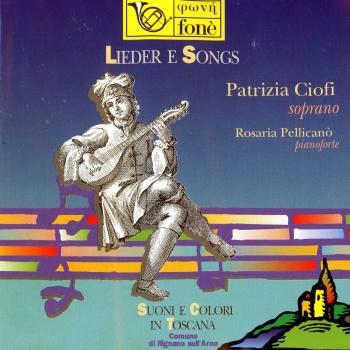
Lieder e Songs Patrizia Ciofi & Rosaria Pellicanò
Album info
Album-Release:
1997
HRA-Release:
18.01.2023
Label: fonè Records
Genre: Classical
Subgenre: Vocal
Artist: Patrizia Ciofi & Rosaria Pellicanò
Composer: Wolfgang Amadeus Mozart (1756–1791), Franz Schubert (1797-1828), Robert Schumann (1810-1856), George Gershwin (1898-1937), Leonard Bernstein (1918-1990)
Album including Album cover Booklet (PDF)
- Wolfgang Amadeus Mozart (1756 - 1791): Abendempfindung:
- 1 Mozart: Abendempfindung 05:19
- An Chloe:
- 2 Mozart: An Chloe 02:53
- Trennungslied:
- 3 Mozart: Trennungslied 05:21
- Franz Schubert (1797 - 1828): Standchen:
- 4 Schubert: Standchen 04:15
- Gretchen am Spinnrade:
- 5 Schubert: Gretchen am Spinnrade 03:45
- Robert Schumann (1810 - 1856): Mondnacht:
- 6 Schumann: Mondnacht 03:39
- Der Nussbaum:
- 7 Schumann: Der Nussbaum 03:48
- Ich grollenicht:
- 8 Schumann: Ich grollenicht 01:42
- George Gershwin (1898 - 1937): Someone to watch over me:
- 9 Gershwin: Someone to watch over me 03:04
- I got rhythm:
- 10 Gershwin: I got rhythm 01:59
- The man I love:
- 11 Gershwin: The man I love 03:00
- Summertime:
- 12 Gershwin: Summertime 02:16
- Leonard Bernstein (1918 - 1990): West Side Story, Somewhere:
- 13 Bernstein: West Side Story, Somewhere 02:24
- West Side Story, Maria:
- 14 Bernstein: West Side Story, Maria 02:47
- West Side Story, Tonight:
- 15 Bernstein: West Side Story, Tonight 05:39
- Robert Schumann: Ich grollenicht:
- 16 Bernstein: Ich grollenicht 01:34
Info for Lieder e Songs
The festival "Suoni e Colori in Toscana" (Sounds and Colours in Tuscany) has, during the past years, become an important event. It has gained the unconditional approval of music lovers for the originality of its contents and for the quality of the music it offers.
The album we are proposing, fully demonstrates our effort to highlight this cultural event. This is part of a vaster project to promote our area which is renouned for its many values and talents.
I wish to thank the publisher Fonè for his valuable and competent work, and I hope that this event will prove to be the first of many more. (Massimo Settimelli, Mayor of Rignano sull'Arno)
While strolling in a garden you can make a beautiful bouquet by picking any of its endless variety of flowers. This is exactly what the Lieder anthology did. It picked music coming from various musical and poetic sources born either as individual or as being part of a musical cycle and above all coming from different cultural times (even if this chronological period spans only half a century). What is exactly the Lied? It can be truly qualified as the overtly idealized expression of a state of being characterized by a regular melodic structure based on popular songs. One can thus achieve a definition which could, with referral to the historical period dealt with, be included in a good dictionary. But the Lied is above all something different. Its text, either by mentioning joy or sorrow, through a picture, an image of nature or daily life, achieves a fleeting tie with human existence. It lasts only an instant, it can vanish when mentioned or be changed by different subsequent moods. A timeless wish, longing for what was barely perceived or what never was.
Let's look at the titles of this anthology. We find three of the best Lieder by Mozart, all dated 1787. They all show an ante litteram approach to the expressive dimension which can itself be defined romantic. They are a leading path in the itinerary of the Lied because they mark the transition between the humble sphere of home usage and the splendour of artistic music. They are pieces that are not always based on texts of high poetic content but the music makes the miracle and it makes them become highly passionate like Abendemphindung (a foreboding sunset). Just like the touching love song for Cloe, in which the opera air still floats with delicate movements. Till the Trennungslied which surges to remind how oblivion can cancel in a few moments what love has given for years. ...
Patrizia Ciofi, soprano
Rosaria Pellicanò, pianoforte
Mauro Ceccanti, direction
Patrizia Ciofi
A native of Casole d'Elsa, Tuscany, Patrizia Ciofi is one of today's most versatile sopranos, with a discography that already includes over fifty recordings. Born in 1967 and trained in neighbouring Siena, she made her professional debut in 1989 at the Teatro Comunale in Florence, which was followed by engagements in other Italian houses, initially mainly in Mozart roles, and shortly afterwards also in Verdi operas. Her role debut as Lucia di Lammermoor in Savona (1996) marked her final breakthrough; an invitation to La Scala in Milan followed, where she sang Violetta in "La Traviata" with groundbreaking success in 1997. Further important debuts at international houses such as the Opéra Bastille in Paris, the Royal Opera House Covent Garden and the Lyric Opera Chicago followed in the following years, followed by her long-awaited debut at the Vienna State Opera in 2008. Ciofi has made a name for herself in the course of her career with a variety of roles between early music, Mozart and bel canto characters, as Gilda or Mimì, and above all in the French repertoire, where she set standards as Marie in Donizetti's La fille du régiment, in the title role of Giacomo Meyerbeer's "Dinorah", as Isabella in his "Robert le diable" and above all as Marguerite de Valois in "Les Huguenots" or also as Leila in Bizet's "Pearl Fishers", Juliette in Charles Goundo's "Romeo et Juliette". In 2017, she made her role debut as Bellini's Norma in Liège and thrilled audiences in the 2018/19 season as the Primadonna in Gaetano Donizetti's comic opera "Viva la Mamma" in Geneva.
Booklet for Lieder e Songs







